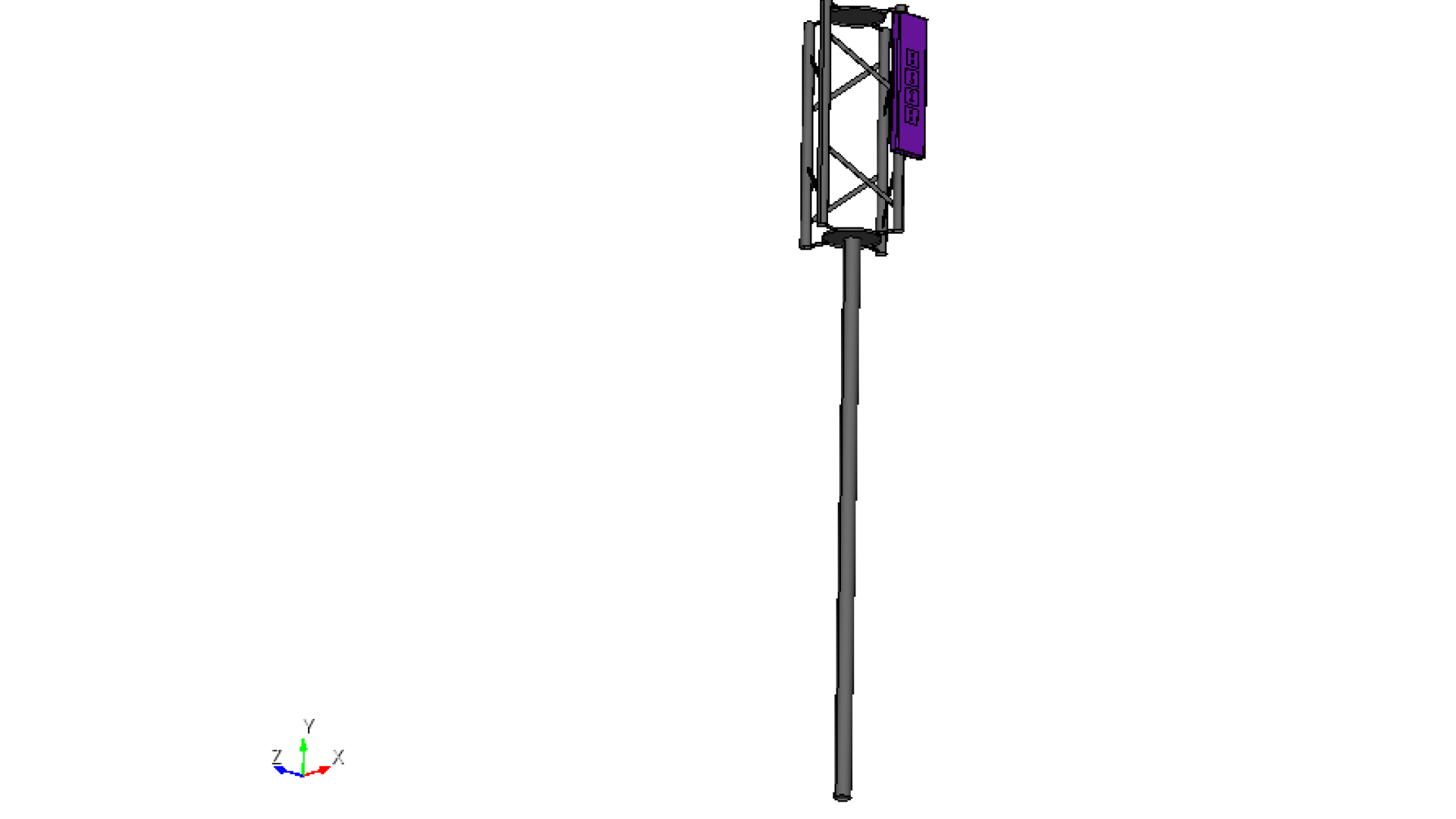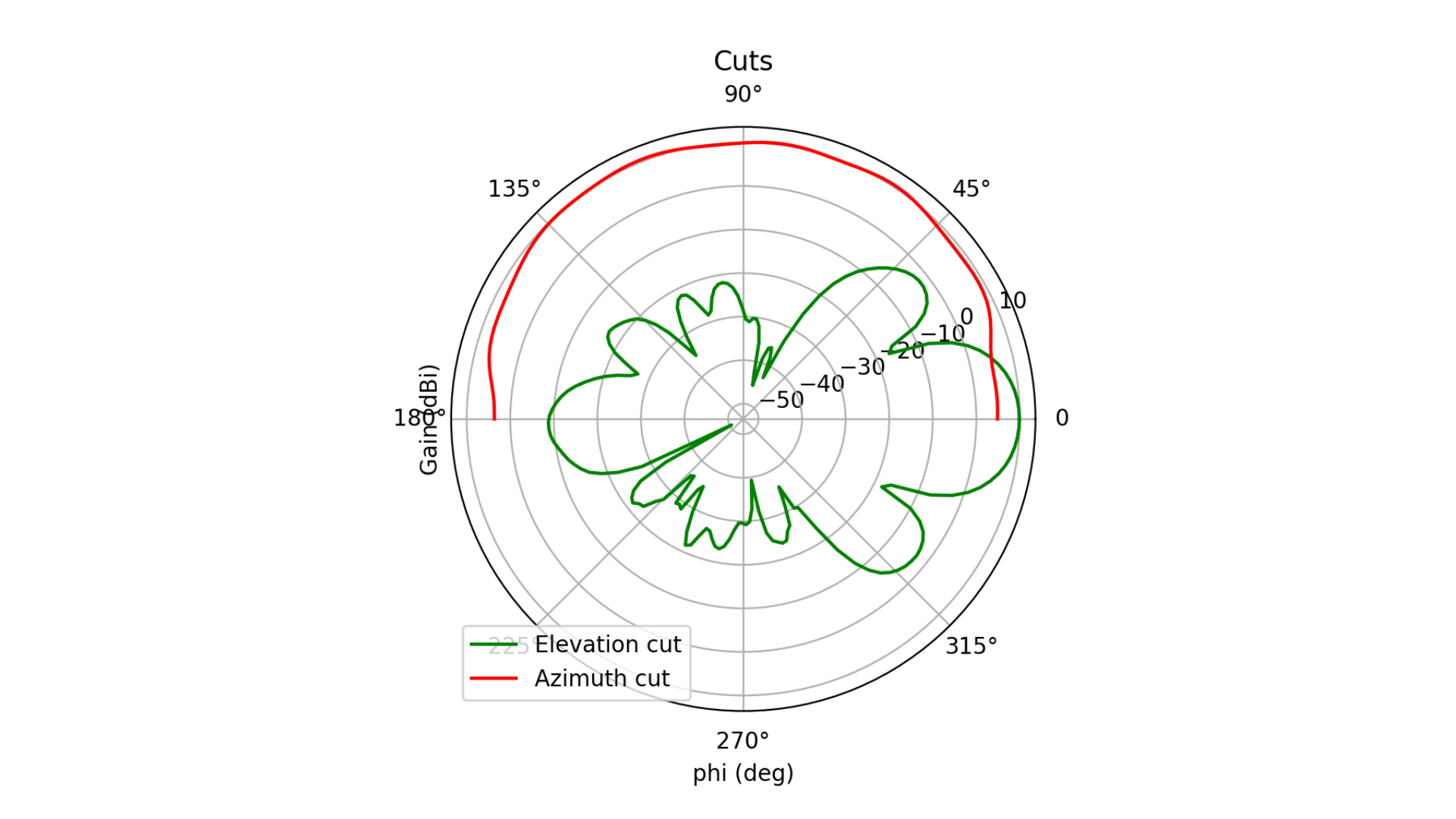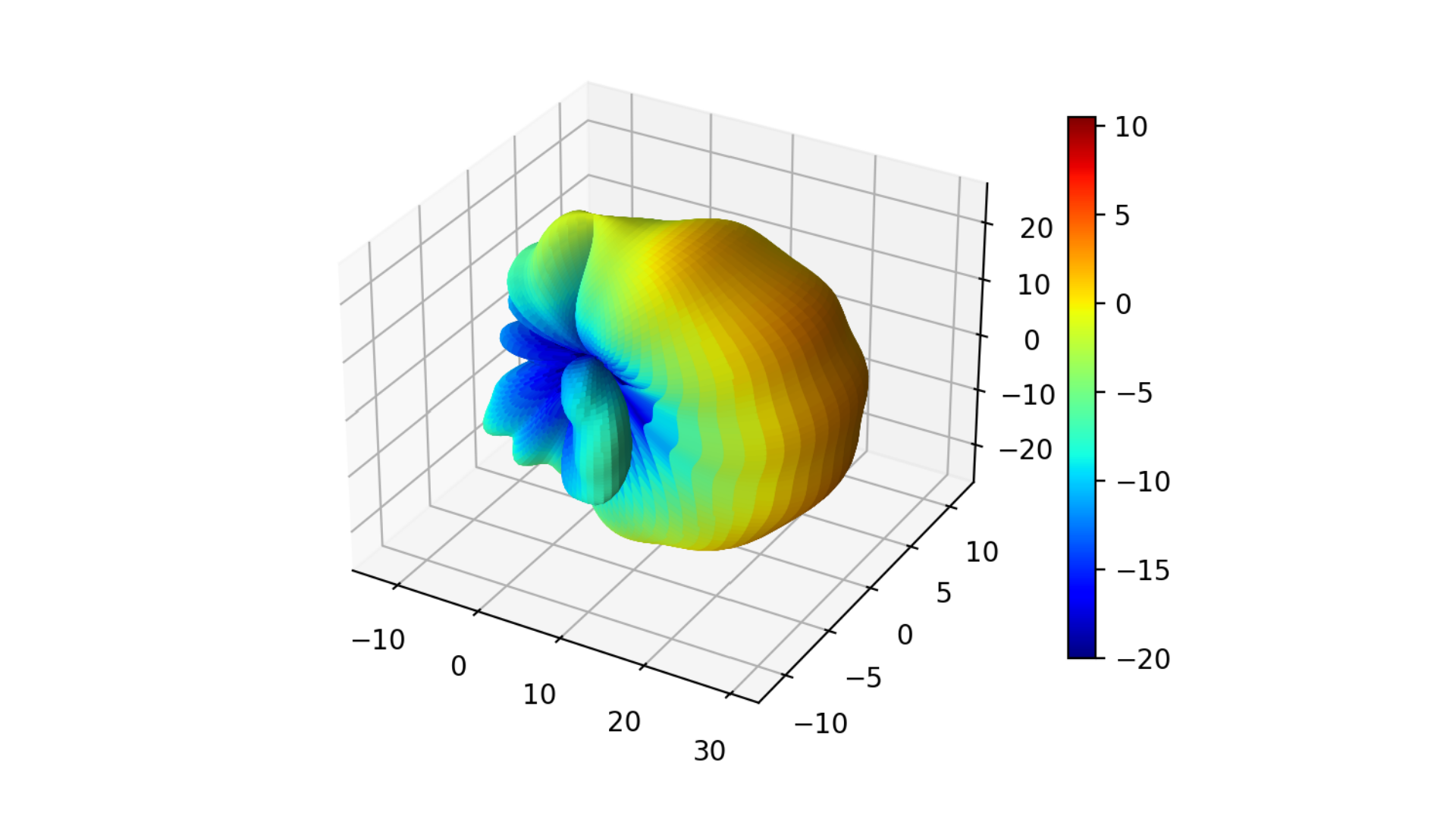Antenna Array Installation Simulation Tutorial
This is part 5 of a 6-part tutorial series hosted by experienced antenna engineer Katerina Galitskaya who is documenting her experience learning Nullspace as a new user. Over six tutorials she will progress from simulating a single bow-tie antenna to building full arrays and exploring beamforming techniques, sharing direct comparisons to other full-wave 3D EM simulation tools.
The full video version of this tutorial is available to watch on YouTube.
Problem Statement
This tutorial presents the modeling, simulation, and post-processing of an electrically large problem - a 4-element antenna array installed on a 10-meter telecom tower. The free-space performance of an antenna can differ significantly from its installed performance. Therefore, simulating the antenna array in its actual installation environment is essential for accurate performance evaluation. The final 3D geometry is shown in Figure 1.
Fig. 1 Integrated antenna array on a tower
Model setup
Preparation: Use the antenna array model from the third tutorial.
Units: CAD model is defined in millimeters, converted to meters during simulation.
Frequency sweep: 0.5–1.5 GHz (51 points).
Radiation data: Dense far‑field grid (2-degree step in theta and phi).
Extracted metrics: Active S-parameters, boresight gain, gain vs. frequency, 2D radiation cuts, and 3D radiation pattern.
CAD Model and Meshing
Begin by opening Prep and setting your working directory to a folder where you plan to complete this example.
Complete the modeling of a 4-element antenna array as described in the previous tutorial.
#{inner_width=1.7}
#{outer_width=30}
#{leng=42}
#{port=1.7}
#{subH=0.767}
#{subW=140}
###substrate geometry
brick x {subW} y {subW} z {subH}
volume 1 rename "substrate"
move Volume substrate z {-subH/2} include_merged
###ports geometry
create vertex {-port/2} {-port/2} 0
#{v1 = Id("vertex")}
create vertex {port/2} {-port/2} 0
create vertex {port/2} {0} {port/4}
create vertex {-port/2} {0} {port/4}
create surface vertex {v1} to {v1+3}
#{port_pos = Id("surface")}
surface {port_pos} copy reflect y
#{port_neg = Id("surface")}
###antenna geometry
create curve location {-outer_width/2} {port/2+leng} 0 location {outer_width/2} {port/2+leng} 0
#{c1 = Id("curve")}
create curve location {-outer_width/2} {port/2+leng} 0 location {-inner_width/2} {port/2} 0
create curve location {outer_width/2} {port/2+leng} 0 location {inner_width/2} {port/2} 0
create curve location {-inner_width/2} {port/2} 0 location {inner_width/2} {port/2} 0
create surface curve {c1} to {c1+3}
#{dipole_top = Id("surface")}
surface {dipole_top} copy reflect y nomesh
#{dipole_bot = Id("surface")}
project surface {port_pos} {port_neg} onto surface 1 imprint
project surface {port_pos} {port_neg} {dipole_top} {dipole_bot} onto surface 2 imprint
###ground plane
create surface rectangle width 300 zplane
#{GND = Id("surface")}
#{gnd_H=70}
move Volume 6 z {-gnd_H} include_merged preview
move Volume 6 z {-gnd_H} include_merged
###4-element array creation
Volume 1 2 3 4 5 6 copy move x 0 y 170 z 0 repeat 3 group_results
unite surface {GND} 36 53 70
#{GND = Id("surface")}
import step "radome.step" heal group "radome" ### importing step file of the radome
#{radome = Id("volume")} ### getting a variable for the radome volume ID
move volume {radome} y -170 include_merged #### center the radome to array geometry
rotate Volume all angle 90 about Y include_merged preview
rotate Volume all angle 90 about Y include_merged
Import the STEP file for the telecom tower. Ensure that the file path is correctly specified.
###tower import
import step "TelecomMast_simplified.step" heal group "Tower"
#{tower = Id("volume")}
Position the tower so the antenna array is mounted on one of the poles.
move volume {tower} x -580 y -11000 z 130 include_merged
Simplify the mast geometry by removing unnecessary small features and surfaces. Some simplifications require decomposing a volume into simpler parts using the webcut function.
### Remove small features and surfaces from tower model
remove surface 181, 200 connected_sets
remove surface 88, 170, 199 connected_sets
select surface 183 include similar
remove surface 179, 183 connected_sets
select surface 198 118 203 include similar
remove surface 118, 198, 203, 204 connected_sets
remove surface 168
remove surface 182, 201 connected_sets
remove surface 154, 202 connected_sets
remove surface 180
remove surface 184
select surface 143 207 include similar
remove surface 143, 151, 206, 207 connected_sets
remove surface 187
remove surface 91, 92, 126 connected_sets
remove surface 122, 150, 158 connected_sets
remove surface 99, 134, 167 connected_sets
webcut volume 26 with sheet extended from surface 146
webcut volume 27 with sheet extended from surface 205
delete volume 27
remove surface 123, 127, 128 connected_sets
imprint all
merge all
Materials & Voltage Sources
Use the material.py script to define the material library. Besides PEC, this model uses FR-4 and glass fiber. Open the Nullspace EM environment and load the material.py file before assigning materials.
from nsem import *
ml=MaterialLibrary()
ml.add_material(Material('FR-4', 'green', MaterialProperty('constant',real=4.4, losstan=0.02), MaterialProperty('constant',real=1.0, imag=0.0)))
ml.add_material(Material('glassfiber', 'grey', MaterialProperty('constant',real=4.7, losstan=0.09), MaterialProperty('constant',real=1.0, imag=0.0)))
ml.save('materials')
Assign materials and define four voltage sources. Ensure consistent assignment of positive and negative terminals across all ports.
nsem load material library 'materials.h5'
nsem assign volume substrate material 'FR-4' ###the original substrate
nsem assign volume 7 13 19 material 'FR-4' ###the 3 copies
nsem assign volume {radome} material 'glassfiber' ### glass fiber material to the radome
nsem assign surface {dipole_top} {dipole_bot} material 'PEC' ###the original antenna
nsem assign surface 34 35 36 51 52 53 68 69 70 material 'PEC' ###the 3 copies
nsem assign surface {GND} material 'PEC' ### ground plane material
nsem assign volume {tower} 28 material 'PEC' ### telecom tower material
nsem voltage source 'port_001' pos surface {port_pos} neg surface {port_neg} impedance 50
nsem voltage source 'port_002' pos surface 32 neg surface 33 impedance 50
nsem voltage source 'port_003' pos surface 49 neg surface 50 impedance 50
nsem voltage source 'port_004' pos surface 66 neg surface 67 impedance 50
Meshing
Repeat the meshing as shown in the previous tutorial. Use lambda/10 meshing for the telecom mast.
###meshing
surface all scheme pave
#{mesh=0.3/1*1000/10}
###port meshing
group 'feed' add surface {port_pos} {port_neg} 32 33 49 50 66 67
curve common_to surface in feed interval 1
mesh surface in feed
###antenna meshing
surface {dipole_top} {dipole_bot} 34 35 51 52 68 69 size {mesh/4}
mesh surface {dipole_top} {dipole_bot} 34 35 51 52 68 69
surface 14 16 17 18 size {mesh/4}
mesh surface 14 16 17 18
surface {GND} size {mesh/1.5}
mesh surface {GND}
surface not is_meshed in volume 1 7 13 19 size {mesh/4}
mesh surface not is_meshed in volume 1 7 13 19
###radome meshing
surface not is_meshed in volume {radome} size {mesh}
mesh surface not is_meshed in volume {radome}
### telecom tower meshing
###small features
surface 102 size 20
mesh surface 102
surface 224 size 20
mesh surface 224
###rest of the tower meshing
surface not is_meshed in volume {tower} size {mesh}
mesh surface not is_meshed in volume {tower}
surface not is_meshed in volume 28 size {mesh}
mesh surface not is_meshed in volume 28
Generate a mesh quality plot to identify potential problem areas.
quality surface all shape global draw mesh
save cub5 "tower_array.cub5" overwrite journal
Fig. 2 Model with the mesh quality plotted.
Simulation Setup
Create a simulation.py file to configure the simulation parameters. Since the structure is electrically large, use the compression solver, which performs matrix compression and leverages near- and far-field coupling to efficiently represent the system.
from nsem import *
import numpy as np
config = 'tower_array'
model = Configuration(f'{config}_sim') #configure simulation name
model.set_cub5_filename(f'{config}.cub5') #load the mesh file
model.set_order(1) #set basis order, default is 1
model.set_model_scale(0.001) #convertion to mm
model.set_frequencies(freq_beg=0.5, freq_end=1.5) #set frequency sweep from 0.5 to 1.5 GHz
model.set_solve_type(solver='COMPRESS') #change the solver type
model.save()
report = Report(f'{config}_report', f'{config}_sim') #create a report object
report.set_frequencies(np.linspace(0.5, 1.5, 11))
step = 2 #set the step for theta and phi angles
theta_scan = np.linspace(0, 180, int(180/step+1)) #theta angles from 0 to 180 degrees
phi_scan = np.linspace(0, 360, int(360/step)) #phi angles from 0 to 360 degrees
report.request_far_fields_grid(theta_scan, phi_scan) #request far-field data
report.save() #save the report configuration
model.run() #run the simulation
report.run() #run the report generation
Post-Processing
Create postprocessing.py to extract simulation data and visualize results.
import matplotlib.pyplot as plt
import numpy as np
from nsem.postprocessing import *
from scipy.interpolate import CubicSpline
config = 'tower_array'
post = PostProcess(f'{config}_sim') # create a post-processing object for the simulation
freq = post.get_frequencies() # get the frequencies
freq = np.linspace(np.min(freq), np.max(freq), 501) # create a frequency array for evaluation
w = [1.0, 1.0, 1.0, 1.0] # excitation of each port
active_s = post.get_active_s_parameters(freq_evaluate=freq,weights=w)
active_s11 = dB20(np.squeeze(active_s[0, :]))
active_s22 = dB20(np.squeeze(active_s[1, :]))
active_s33 = dB20(np.squeeze(active_s[2, :]))
active_s44 = dB20(np.squeeze(active_s[3, :]))
#plots
fig = plt.figure(figsize=(18, 6))
ax1 = plt.subplot(1, 3, 1)
ax2 = plt.subplot(1, 3, 2)
ax3 = plt.subplot(1, 3, 3, polar=True)
# active S-parameters
ax1.plot(freq, active_s11, label='active S11', color='blue')
ax1.plot(freq, active_s22, label='active S22', color='orange')
ax1.plot(freq, active_s33, label='active S33', color='green')
ax1.plot(freq, active_s44, label='active S44', color='red')
ax1.set_xlabel('Frequency (GHz)')
ax1.set_ylabel('S11 (dB)')
ax1.set_title('Active S-parameters')
ax1.grid(True)
ax1.legend()
Fig. 3 Active S11 for each port
post = PostProcess(f'{config}_report') # create a post-processing object for the report
freq = post.get_frequencies()
theta = post.get_obs_theta()
phi = post.get_obs_phi()
gain = post.get_gain('spherical',weights=w) #get gain with specified amplitude/phase distribution
theta_idx,_ = post.get_nearest(theta, 0.0)
phi0_idx,_ = post.get_nearest(phi, 0.0)
phi90_idx,_ = post.get_nearest(phi, 90.0)
theta90_idx,_ = post.get_nearest(theta, 90.0)
theta0_idx,_ = post.get_nearest(theta, 0.0)
freq_idx,_ = post.get_nearest(freq, 1.0)
gain_0 = gain[phi0_idx, theta90_idx, 0, freq_idx, 1]
print(f"Boresight gain (dBi): {gain_0:.2f}")
gain_copol_phi0 = gain[phi0_idx, :, 0, freq_idx,1]
gain_copol_phi90 = gain[phi90_idx, :, 0, freq_idx, 0]
gain_xpol_phi0 = gain[phi0_idx, :, 0, freq_idx, 0]
gain_xpol_phi90 = gain[phi90_idx, :, 0, freq_idx, 1]
gain_copol_theta90 = gain[:, theta90_idx, 0, freq_idx, 1]
gain_xpol_theta90 = gain[:, theta90_idx, 0, freq_idx, 0]
#Gain plot interpolation
gain_max = np.squeeze(gain[phi0_idx, theta90_idx, 0, :, 1])
x = np.asarray(freq).ravel()
y = np.asarray(gain_max).ravel()
x_unique, idx = np.unique(x, return_index=True)
y_unique = y[idx]
cs = CubicSpline(x_unique, y_unique, bc_type='natural', extrapolate=False)
x_dense = np.linspace(x_unique[0], x_unique[-1], 501)
y_dense = cs(x_dense)
# Gain vs frequency
ax2.plot(x_dense, y_dense, label='Gain with radome', color='blue')
ax2.set_xlabel('Frequency (GHz)')
ax2.set_ylabel('Gain (dBi)')
ax2.set_title('Boresight Gain vs Frequency')
ax2.grid(True)
ax2.legend()
Fig. 4 Boresight gain over frequency
# Elevation and azimuth cuts
ax3.plot(np.deg2rad(phi), gain_copol_theta90, label=f'Co-pol theta=90°', color='green')
ax3.plot(np.deg2rad(theta), gain_copol_phi0, label=f'Azimuth cut', color='red')
ax3.set_xlabel('phi (deg)')
ax3.set_ylabel('Gain (dBi)')
ax3.set_title('Cuts')
ax3.grid(True)
ax3.legend()
fig.tight_layout()
Fig. 5 Elevation and Azimuth cuts
#3D radiation pattern
fig3d,ax3d = post.plotPolar3D(gain[:,:,0,freq_idx,1], -20.0,20.0)
fig3d.show()
plt.show()
Fig. 6 3D gain pattern






